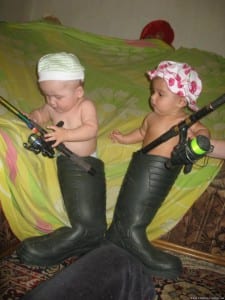By taking advantage of the reduced water levels of the lakes the staff was able to get equipment and material into the necessary locations to improve fish habitat. More habitat articles at fishiding.com
The county-managed lakes where the habitat improvement projects were completed are Fin and Feather and Clark Lake at the Mike Zack wildlife area and the lake at the Bluebill wildlife area. Three spawning beds were installed at Fin and Feather Lake, two at Clark lake and three at Bluebill.
The purpose of a pea gravel fish spawning structure is to improve the reproductive success of panfish species such as bluegill.
A process of panfish reproduction involves male fish creating a nest site by fanning out a bowl- shaped depression in the lake bottom to provide a site for females to lay their eggs in.
To create the nest the fish must use whatever bottom substrate is available.
In Iowa the majority of nests are constructed in mud or silt as this is the most common bottom structure of many lakes.
These types of nests are moderately successful but they can be easily disturbed and ruined by wind. Windy days stir up the mud and silt and deposit this material into the nests. The mud and silt deposited into the nests buries the eggs which reduces or eliminates nest success.
Recognizing this siltation problem, the County Conservation Board staff worked with an Iowa Department of Natural Resources fisheries biologist to find an improved spawning substrate for panfish in CGCCB managed lakes. The use of pea gravel as a nesting substrate was determined to be the best option available.
The pea gravel improves spawning success by providing a bottom substrate that panfish can still create a nest in, yet is more stable in windy conditions. Without the wind disturbance the nests stay intact and the hatching success of the eggs is dramatically improved.
Capitalizing on the reduced water levels this winter, the conservation board staff was able to place and level pea gravel at appropriate locations for each lake. The spawning beds are constructed by placing a four- to six-inch layer of pea gravel onto the lake bottom.
The layer of pea gravel is located at a depth that is at or slightly below the normal sunlight penetration point for that body of water.
In some lakes this may be two to three feet below the surface; in other lakes this may be eight to 10 feet below the surface. The spawning beds are approximately 15 feet by 30 feet. The completed spawning beds will provide enhanced spawning sites for the panfish in Fin and Feather Lake, Clark Lake and Bluebill.
The fish spawning structures will also provide increased fishing opportunities for anglers at these lakes. The increased spawning success should provide more fish for anglers to pursue via natural reproduction.
Also the spawning beds will be good places to actively fish during the spawning season. Since males typically guard the nests, catching a few fish off of the spawning structures will not greatly impact the fish population.
For more information about this project or where the above county lakes can be located go towww.co.cerro-gordo.ia.us (click on outdoors), stop by the Lime Creek Nature Center at 3501 Lime Creek Road in Mason City, or call the board office 641-423-5309.
Mike Webb is By MIKE WEBB, For The Globe Gazette
Wildlife Area Manager, Cerro Gordo County Conservation Board
